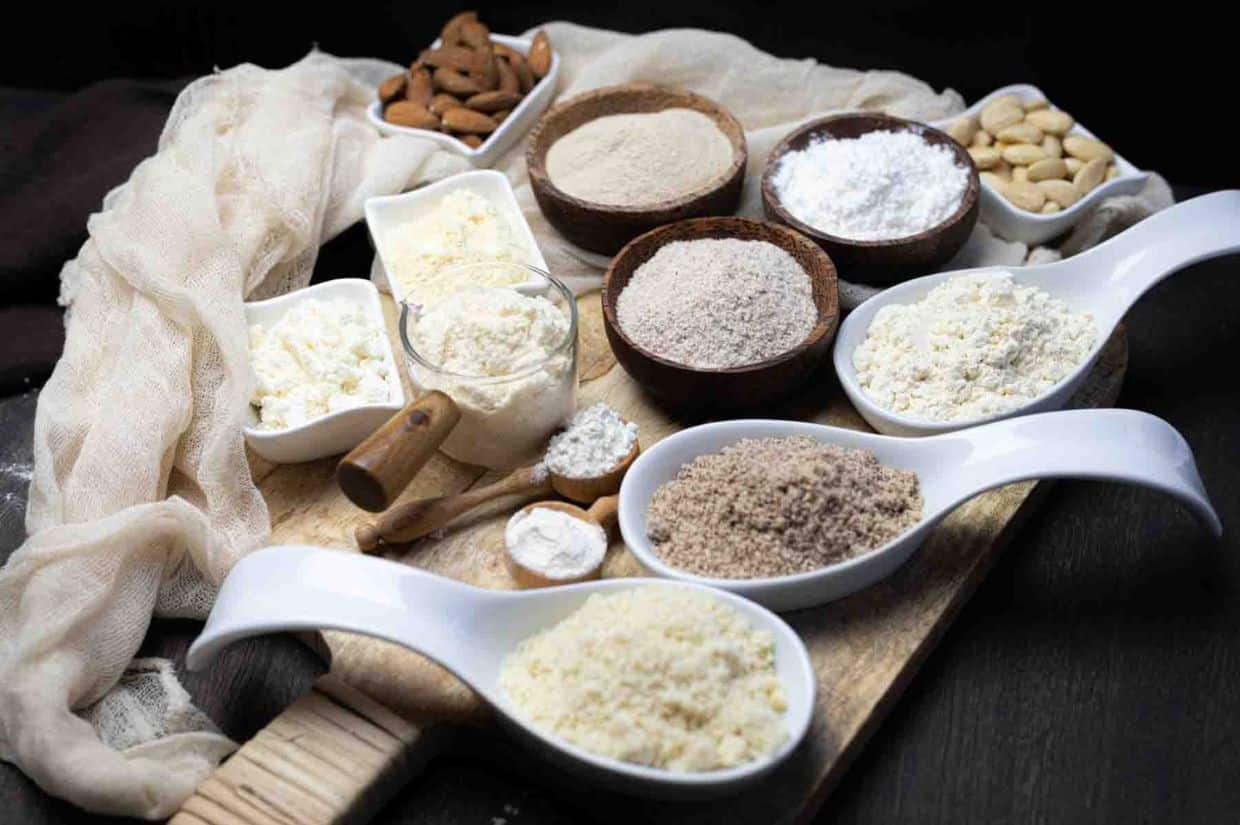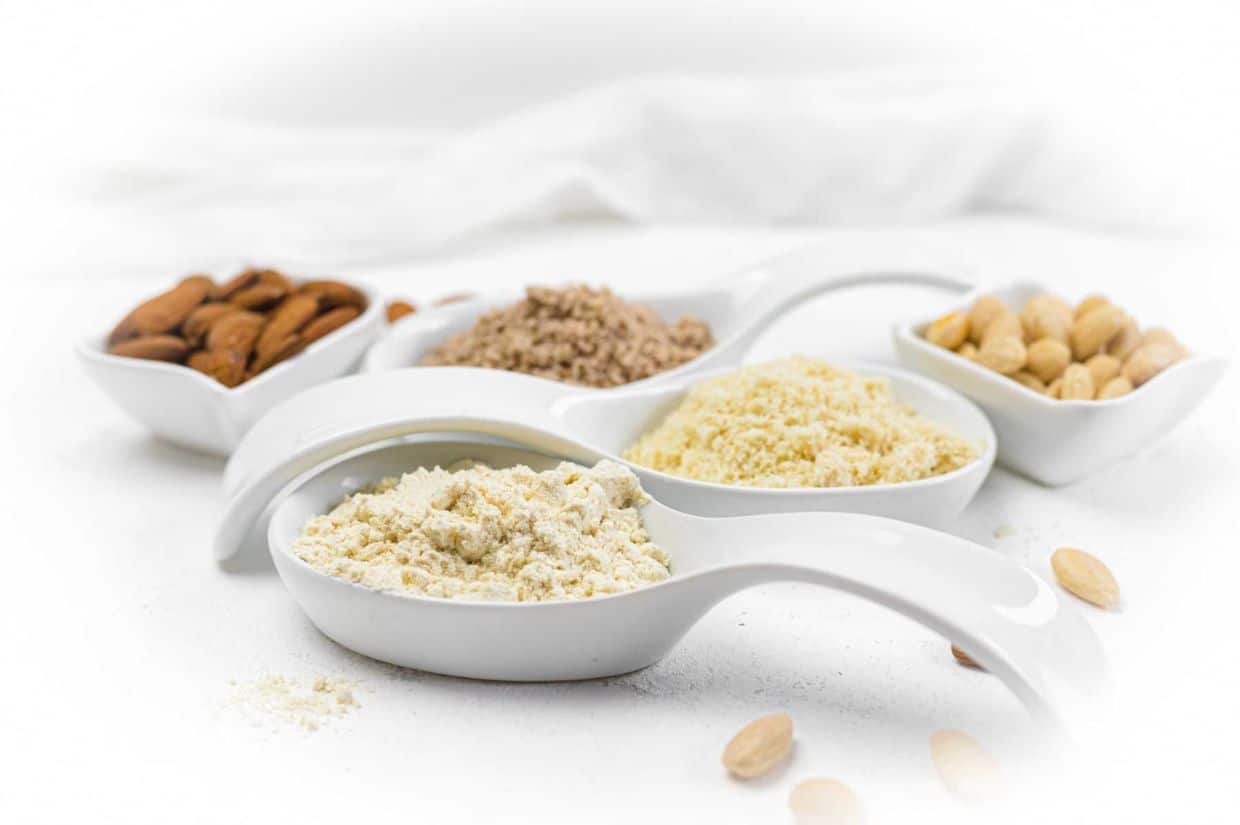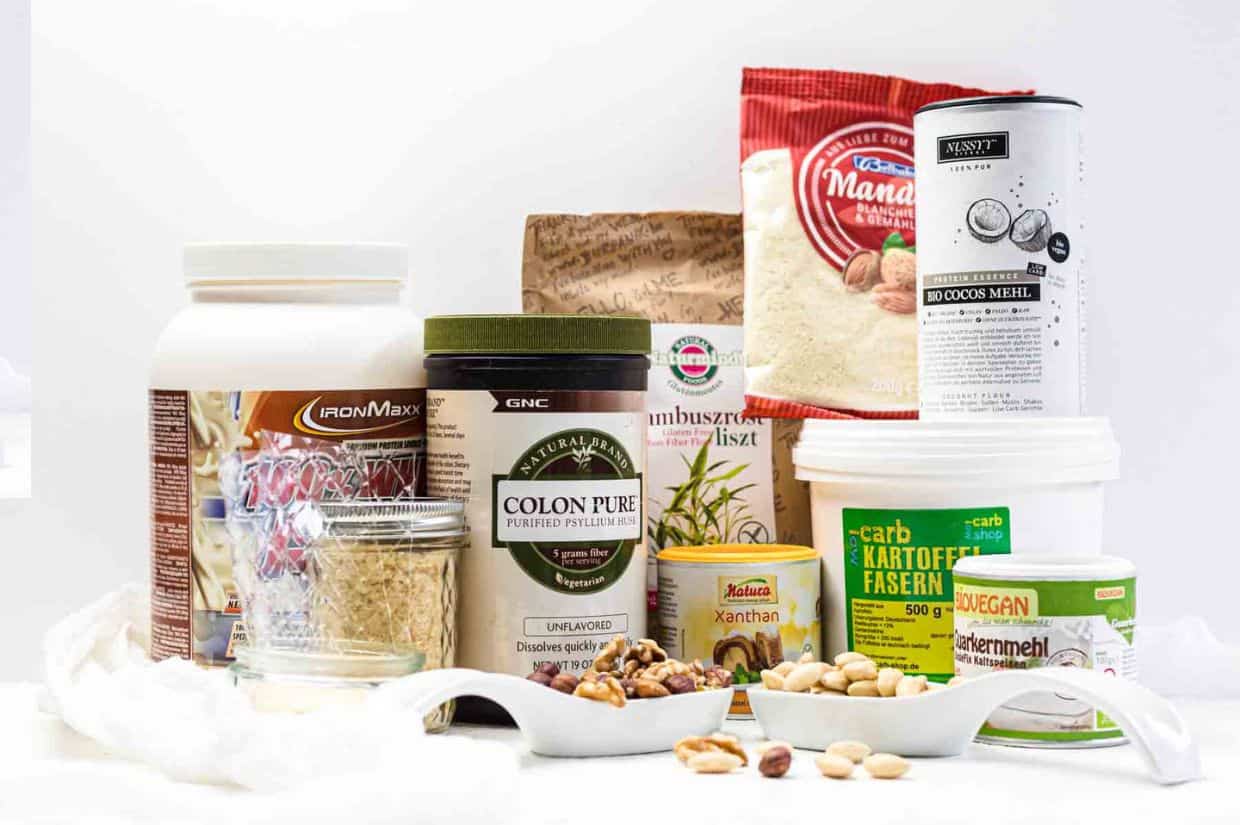Discover low-carb and keto-friendly flour substitutes for your favorite recipes. From the most popular almond flour and coconut flour to various protein powders and binding agents like psyllium or xanthan gum, everything is covered.

The ultimate guide to low-carb flours
There are many flour alternatives you can use in keto and low-carb baking or even in cooking dinner. Following are the most common and best keto substitutes.
Almond flour
Loved and used more than any other alternative flour in keto cooking, almond flour is a great low-carb and keto alternative.
People love almond flour because it’s gluten-free, and it’s also a great choice for anyone on a low-carbohydrate diet.
Almond flour is extremely versatile and can be used in all kinds of baked foods. It packs a potent punch of nutrition, unlike a typical gluten-rich, overly processed flour that does nothing good for your health.
Science has shown that almonds are a natural powerhouse to our body, and if you activate your almonds, the benefits get even better.
Almond flour
Regular almond flour is made of almonds and only almonds, which are first blanched to remove the skin and then ground up to a very fine consistency.
Ground almonds
Ground almonds are very similar to almond flour except that they have a tiny bit coarser consistency. The difference is so minimal that most of the time, you will not even realize it.
The only huge difference is the price. Ground almonds are significantly cheaper than almond flour, so if you are looking to use almond flour regularly and are conscious of the price, ground almonds are a great alternative.
Almond meal
Almond meal is the same as ground almonds but with the skin left on.
It is great to have them at home for cooking and baking. Use them whenever you cook something chocolatey or dark. In darker foods, you won’t see the difference where you might see it in something like a white cake.

Coconut flour
Coconut flour is very popular in the keto lifestyle as it contains fewer calories than other low-carb alternatives, but it contains more carbohydrates per serving.
It is much dryer and denser than other flours, so you need less of it than you do of something like regular almond flour.
This flour is made from ground and dried coconut meat. Once the outer green husk of a coconut is removed, what remains inside is the rich, inner white lining which is the coconut meat.
Coconut flour is not actually “flour” in the way we normally think of it; it contains zero grains or nuts and is made completely of pure coconut. Flour can be made from many things, including nuts, seeds, dried vegetables and of course coconut meat.
There are numerous reasons to love all that coconut flour nutrition has to offer, especially the fact that it’s low in calories, and can be used in many different types of recipes.
Substituting coconut flour for almond flour
The ratio of almond flour to coconut flour is 4 to 1. So for every cup of almond flour, a recipe calls for, you can replace it with ¼ cup of coconut flour.
Remember that you will get a slight coconut taste when using coconut flour.
Fibers
Dietary fibers are a perfect addition to your diet. Solubles such as oat fiber and psyllium are pretty popular in keto baking.
Filled with appetizers, salads, sides, mains and desserts, Food Drink Life's cookbook will become your favorite!
- Easy and delicious recipes from a variety of top chefs and recipe developers.
- Bright, colorful pictures on every page.
- Printer-friendly recipes that you can download instantly to your device.
- Printable shopping list and a kitchen conversion sheet.
Psyllium husk
Psyllium husk is the most known fiber used in keto cooking and baking.
Although psyllium husk is not flour, it is a great addition to any low-carb pantry.
Psyllium husk is all fiber and is used as a colon cleanser. In baking, it can add volume and act as a thickener to help the recipes bind together. This gives your baked goods a great crumb-like texture.
Potato fiber
Not known or available in the US, this keto fiber is a perfect addition to baking and cooking in our lifestyle.
With 8 grams of carbohydrates in 100 grams of fiber, it is identical to almond flour, with consistency that is more like bread flour.
Potato fiber has been well known in Scandinavian countries and Germany, where it is used in keto farmer’s bread, which has the look, feel, smell and taste of ordinary farmer’s bread.
Oat fiber
Similar to potato fiber, oat fiber is a great addition to keto baking and, most importantly, is available all over the US. It is a great replacement in any recipe that calls for potato fiber.
Bamboo fiber
Another great insoluble fiber, bamboo fiber has a beautiful snow-white color and can be used like potato and oat fiber.
Flax meal
Flax meal is also known as ground flax, ground flaxseeds, or linseed. What’s great about baking with flax meal is that not only can it replace flour in recipes, but it can also replace eggs in recipes.

Protein powders
One of the many magical properties of gluten is that it helps baked goods rise and hold their shape. Since gluten is a protein, subbing in another protein in its absence can help.
I like to use unflavoured whey protein or
When buying protein, always check if it contains sugar because some do, especially the flavored ones.
Binding agents
Binding agents are crucial in many recipes as they hold ingredients together and give structure to baked goods. Without them, your cookies and cakes might fall apart.
Xanthan gum
A thickening agent or a stabilizer, xanthan gum is a perfect addition when you want your baked goods to hold together.
Xanthan gum is pricey, but with baking, you need only a small tiny bit, so one small box lasts a long time.
Guar gum
Very similar to xanthan gum, guar gum serves the purpose of binding ingredients.
The difference between xanthan gum and guar gum
Dough made with xanthan gum is sticky, so it is best to use wet or oiled hands when working with it.
Guar gum does not make the dough sticky the way xanthan gum does, so you can work with it with dry hands.
Pork rinds
Pork rinds, either bought or homemade, work as a keto and low-carb flour substitute, as well.
Grind the pork rinds into flour and use the flour for breading meats like schnitzel. It adds a perfect crunch to the final goods.
Nutritional yeast
Very similar to the pork rinds,nutritional yeast is perfect to use for breading chicken, chicken nuggets, or just added to any keto food. With its salty and crunchy flavor and texture, it’s a great ingredient to have in your kitchen pantry.
Keto breadcrumbs
Making your own breadcrumbs out of keto bread couldn’t be easier.
Breadcrumbs are great to use as binding agents or as a coating for fried food.
Homemade low-carb breadcrumbs are super easy to make and you can store them in your fridge for months.
Low-carb flour can be also made from :
- Sunflower seeds
- Pumpkin seeds
- Chia seeds
- Grapeseed
- Hemp seeds
- Sesame seeds
- Walnuts
- Hazelnuts

How to store keto and low carb flours
Low-carb flour alternatives are best used fresh, but you can store them in mason jars or one of the food storage containers in either your fridge or freezer. They’ll stay much longer compared to if you have them stored on a shelf in your kitchen pantry.
It is advisable to purchase nut flours in small quantities so you do not have to store the open box for a long time.
Can you freeze keto flours?
You can certainly store any of the keto flours in the freezer and it is advisable if you have space. Freezing not only keeps them extra fresh but will prevent them from going bad or getting moldy, which can happen in a very warm or moist environment.
Zuzana is the creative force behind her websites Lowcarb-nocarb and Best Clean Eating. As a content creator, food recipe developer, blogger, and photographer, Zuzana brings diverse skills to the table with a dedication to sharing delicious, healthy recipes and helpful tips with the readers. Get her Best Keto Recipes Book for free.
This article originally appeared on Low Carb – No Carb.
